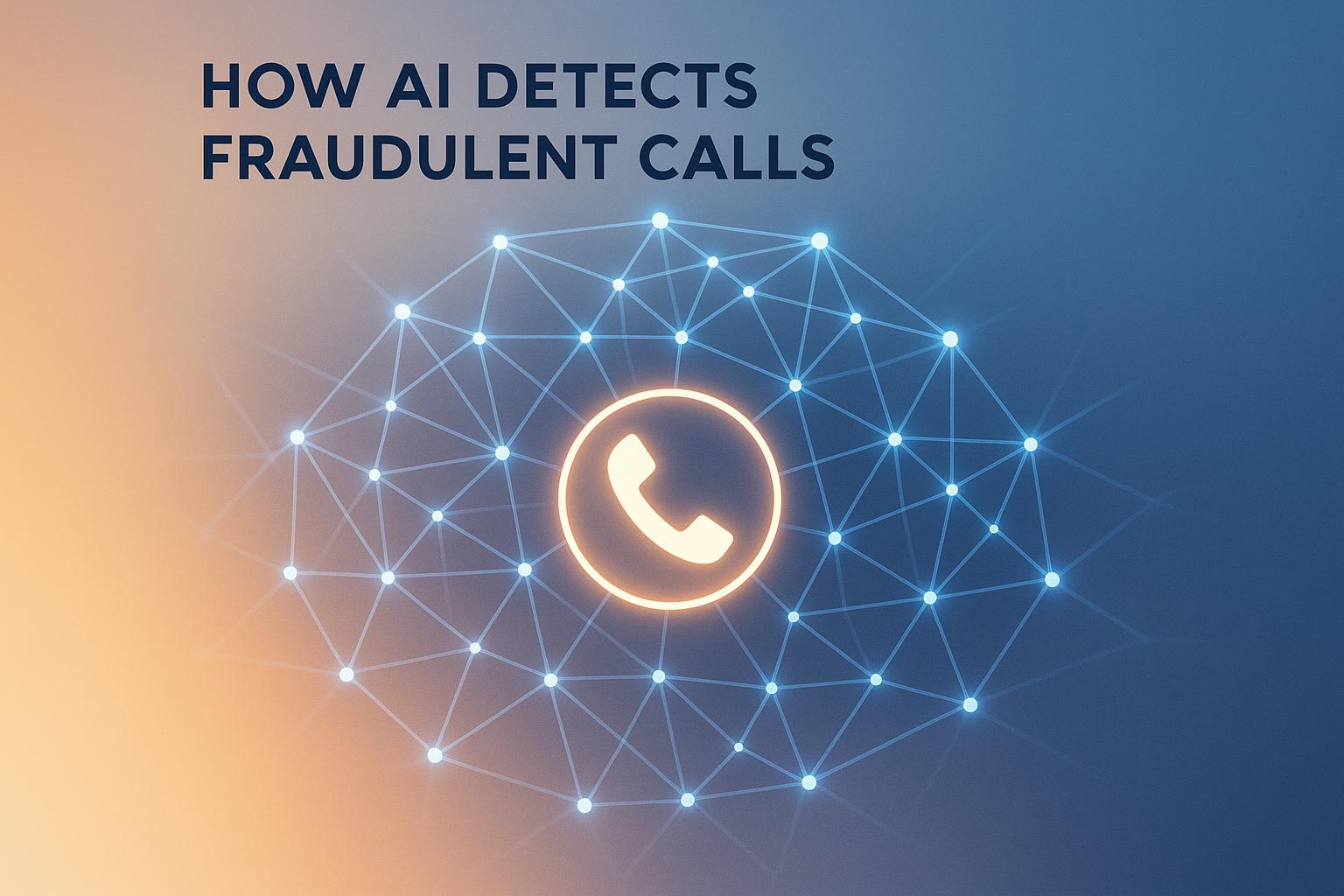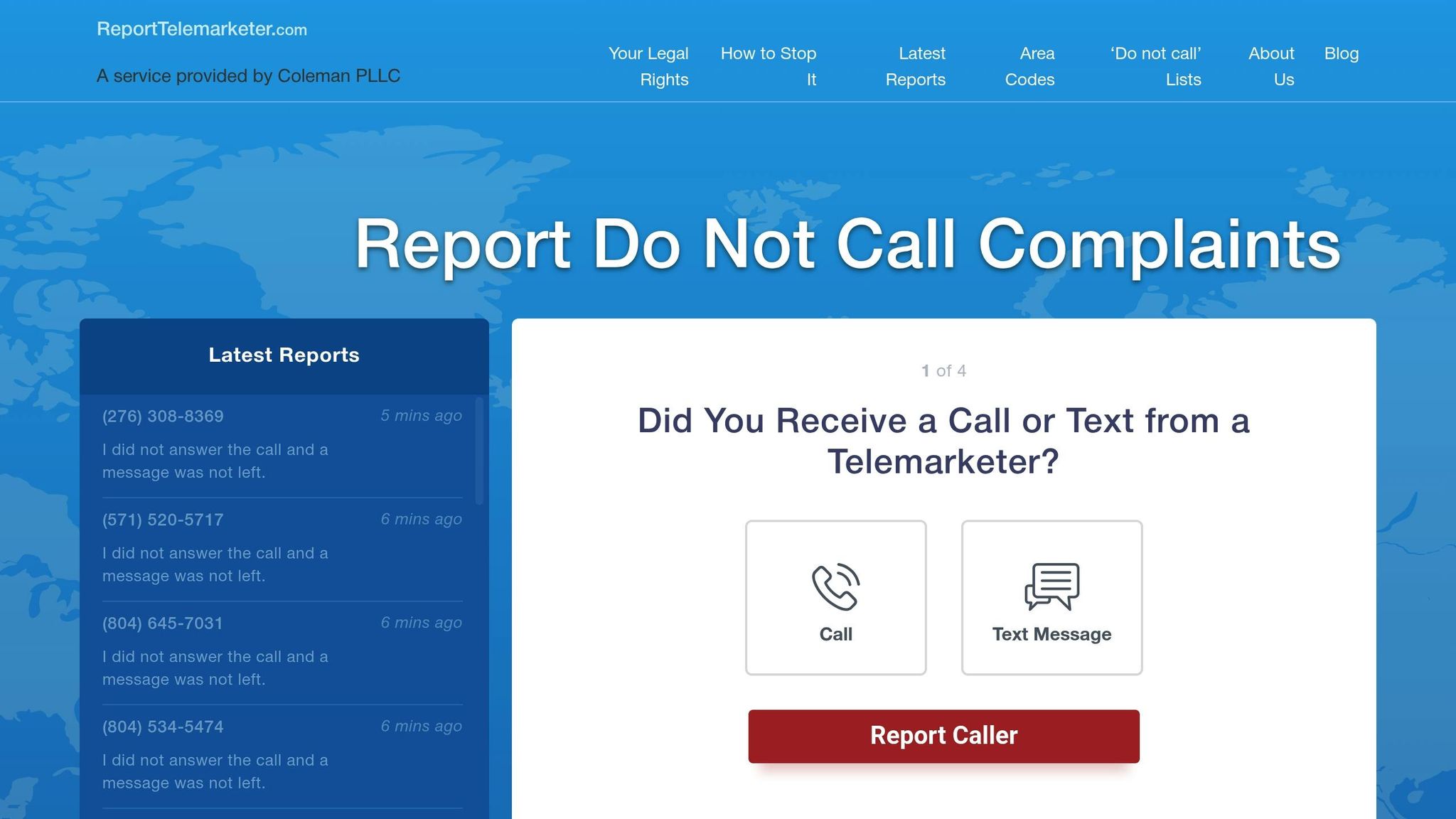
Fraudulent calls are a growing problem, causing financial losses and stress for many. AI systems are now being used to fight back. Here’s how they work:
- Real-Time Detection: AI analyzes call patterns, speech, and metadata instantly to block scams.
- Speech Analysis: Flags robotic tones, aggressive language, or suspicious keywords.
- Privacy Protection: Data is encrypted, anonymized, and securely stored.
- Continuous Learning: AI adapts to new scam tactics by learning from confirmed fraud cases.
These systems protect users from scams while ensuring privacy and maintaining accuracy. For added support, platforms like ReportTelemarketer.com combine AI with legal action to stop persistent telemarketers.
AI Systems for Call Fraud Detection
How AI Detects Fraudulent Calls
AI-powered systems use machine learning to analyze past call data and spot fraud patterns. With natural language processing (NLP), these systems can interpret speech patterns and flag language that hints at scam activity. By examining call metadata – such as frequency, duration, and origin – AI can quickly distinguish between legitimate and suspicious calls.
Breaking Down the Detection Process
The detection process builds on these advanced technologies and typically involves four main steps:
- Collect Data: Gather details like call metadata, timestamps, caller ID, and calling patterns.
- Extract Features: Examine voice characteristics, speech speed, and linguistic clues.
- Train the Model: Use confirmed fraud cases to improve detection precision.
- Real-Time Analysis: Compare incoming calls against known fraud patterns instantly.
These systems continuously learn and evolve, keeping up with new scam tactics as they develop.
Balancing Pattern Detection with Privacy
AI systems are designed to detect fraud while maintaining user privacy. Data is anonymized and encrypted, ensuring that sensitive details are not exposed during the analysis.
| Privacy Feature | How It Works |
|---|---|
| Data Encryption | Metadata is secured with end-to-end encryption. |
| Anonymized Analysis | Behavioral patterns are analyzed without storing personal information. |
| Secure Storage | Only essential data is stored, and it’s encrypted. |
| Access Controls | Strict access policies limit who can interact with the system. |
How to Detect Fraud Calls using AI | Artificial Intelligence …
Main AI Methods in Fraud Detection
AI employs specific techniques to improve the identification of suspicious calls, making the fraud detection process more efficient and accurate.
Call Pattern Analysis
AI systems examine various call attributes to spot unusual activity. For example, numbers making a high volume of short calls within a brief time frame are flagged for review. Here are some patterns AI monitors:
| Pattern Type | Fraud Indicators | Method |
|---|---|---|
| Time Analysis | Calls made during odd hours | Monitoring timestamps |
| Volume Patterns | Excessive call frequency | Tracking call rates |
| Duration Trends | Very short call durations | Measuring call lengths |
| Location Data | Calls from high-risk areas | Analyzing geographic data |
Speech and Language Analysis
AI also evaluates voice and language to identify suspicious behavior. This involves analyzing:
- Speech Patterns: Detects robotic tones, repeated phrases, or unnatural pauses.
- Emotional Markers: Flags aggressive or manipulative tones in the caller’s voice.
- Language Red Flags: Looks for specific keywords often linked to scams.
Fraud Model Updates
AI fraud detection systems stay effective by constantly learning and adapting. This is achieved through machine learning processes that involve:
- Data Collection: Gathering verified examples of fraudulent calls.
- Pattern Recognition: Identifying and integrating new fraud tactics into the system.
- Performance Optimization: Regularly refining detection methods to reduce false positives.
This ongoing learning ensures that fraud detection systems remain capable of handling new and evolving scam techniques, providing strong protection in the telecommunications industry.
sbb-itb-a8d93e1
AI Fraud Detection in Practice
Modern AI call screening systems use advanced detection methods to analyze incoming calls and block scams before they can reach users.
Current AI Call Screening Tools
These systems come equipped with features designed to combat fraudulent calls effectively:
| Feature | Function | Real-Time Action |
|---|---|---|
| Voice Analysis | Identifies synthetic or recorded voices | Blocks suspicious calls instantly |
| Number Verification | Confirms the authenticity of caller IDs | Screens calls before they ring |
| Behavioral Monitoring | Monitors calling patterns for irregularities | Assigns a risk score |
| Language Processing | Flags suspicious scripts or phrases | Provides real-time transcription |
These features form the backbone of ReportTelemarketer.com’s efforts to protect users from call fraud.
ReportTelemarketer.com Services

ReportTelemarketer.com combines user reports with professional investigations to stop unwanted telemarketing calls. Here’s how it works:
- Investigation Process: Once a user submits a report, the platform reviews the call details using proprietary tools to identify potential legal violations.
- Legal Action: If violations are confirmed, the legal team, led by Coleman, PLLC, takes action by filing cease-and-desist letters, submitting complaints, or pursuing other legal remedies.
- Cost-Free Protection: The service is completely free for users. Attorney fees are recovered directly from telemarketers once the calls are stopped.
Users can easily report violations through an online form, triggering an immediate review and action against non-compliant telemarketers.
Pros and Cons of AI Fraud Detection
AI Detection Strengths
AI fraud detection systems are designed to block fraudulent calls instantly, offering a strong layer of protection for consumers. Here’s how they stand out:
| Strength | Description | Impact |
|---|---|---|
| Real-Time Processing | Analyzes calls instantly as they come in | Prevents fraudulent calls from reaching users |
| Pattern Recognition | Spots complex calling behaviors and patterns | Identifies large-scale scams and mass call campaigns |
| Continuous Learning | Updates detection models automatically | Keeps up with new scam tactics |
| Scalability | Handles high volumes of calls effectively | Protects large groups of users simultaneously |
When unusual patterns are detected, the system flags them for review and logs the details. These logs can later support legal actions. However, while AI systems offer impressive capabilities, they’re not without their challenges.
AI Detection Limitations
AI fraud detection systems do have some drawbacks:
- False Positives: Legitimate calls with unusual characteristics may get flagged incorrectly.
- Data Quality Dependence: The system’s accuracy hinges on receiving timely, high-quality data and updated training sets.
- Adaptation Lag: Scammers using new techniques may temporarily evade detection until the system is updated.
To tackle these challenges, platforms like ReportTelemarketer.com combine AI technology with human oversight and legal expertise. This hybrid model ensures that flagged alerts are reviewed by professionals, enabling actions like filing complaints or sending cease-and-desist letters. By blending automated tools with human judgment, this approach builds a stronger, more adaptable defense against fraudulent calls in an ever-changing telecom environment.
Summary
AI-driven fraud detection systems have transformed the way we safeguard consumers from fraudulent and unwanted calls. By leveraging real-time analysis, pattern recognition, and continuous learning, these systems provide a strong defense against phone scams and harassment.
Here’s how these systems work:
| Component | Function | Impact |
|---|---|---|
| Pattern Analysis | Tracks call frequency, timing, and behavior | Flags mass calling campaigns |
| Voice Processing | Examines speech patterns and audio traits | Identifies robocalls and fake numbers |
| Adaptive Learning | Updates models with new data | Keeps up with evolving fraud tactics |
While AI delivers powerful automated screening, human oversight adds an extra layer of protection. Services like ReportTelemarketer.com complement AI tools by investigating suspicious calls. Their legal team can take action, such as sending cease-and-desist letters or filing complaints against violators.
To protect yourself, use AI-based screening tools and report persistent telemarketers through platforms like ReportTelemarketer.com. This combination of technology and legal action ensures a comprehensive approach to tackling fraudulent calls.
The future of fraud detection lies in blending artificial intelligence with human expertise, creating a safer telecommunications experience for everyone.
FAQs
How does AI protect your privacy while identifying fraudulent calls?
AI-powered systems are designed to detect and block fraudulent calls without compromising your privacy. These systems analyze call patterns, behavior, and metadata rather than personal content or sensitive information. By focusing on non-intrusive data, they can identify suspicious activity while keeping your private conversations secure.
Additionally, reputable AI tools comply with strict privacy regulations and implement advanced encryption methods to safeguard user data. This ensures your information remains protected throughout the fraud detection process.
How does AI detect and block fraudulent calls?
AI detects and blocks fraudulent calls by analyzing patterns and behaviors that indicate suspicious activity. Using advanced algorithms, AI systems can identify unusual call volumes, repetitive calling patterns, or spoofed caller IDs. These systems also leverage machine learning to adapt and improve detection over time, recognizing new types of scams as they emerge.
Many AI-powered tools cross-reference calls against databases of known fraudsters or telemarketers. By combining real-time analysis with historical data, these systems can quickly flag and block suspicious calls before they reach your phone. This proactive approach helps protect consumers from scams and unwanted interruptions.
How do AI systems stay ahead of new and evolving phone scams?
AI fraud detection systems use advanced technologies like machine learning and natural language processing to identify and combat fraudulent calls. These systems analyze patterns in call behavior, voice characteristics, and other data points to detect suspicious activity. As scammers develop new tactics, AI models are continuously updated with fresh data to adapt and improve their accuracy.
For example, AI can recognize unusual call patterns, such as a sudden spike in calls from a specific number or region, and flag them as potential scams. Over time, these systems learn to predict and block evolving threats more effectively, helping protect consumers from unwanted or harmful calls.